
“Let’s face it- We sell products. We sell a lot of products, we sell good products.
But it’s hard to get people to engage with sales copy.
We wanted to build a reason to engage and come back that wasn’t just:
“Please buy more”.” - Sean Frank, CEO of Ridge
For every $1 spent on email marketing, there’s an expected average return of $42. And email marketing continues to be the main driver of customer retention and acquisition. 81% of businesses still rely on email as their primary customer acquisition channel, and 80% for retention.
It’s no longer a question of how much effort to put into email marketing. But rather, how do I make email marketing work even better for my brand and customers?
When customers interact with your brand, they go through a journey. And that’s what is defined as the customer lifecycle. There’s no one fixed rule on how a customer engages with your brand but it generally follows a few stages.
Lifecycle emails consider the stage of the customer’s lifecycle—prospect, first-time buyer, repeat customer, lapsed, and so on—to send triggered and relevant messages at the right time. And it’s also about acquisition, retention, and appreciation from the brand’s point of view.
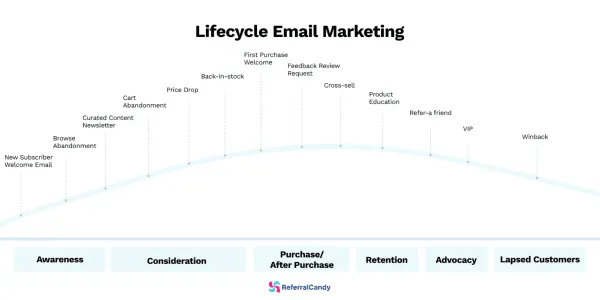
We’ll dive right into the various stages of the customer journey and best practices.
The awareness stage is where a prospect searches for your product or brand after becoming aware of an issue or problem they need to solve. Since this is the initial touchpoint that you have with your customers, being too aggressive by trying to hard sell is a definite no-go.
There are several ways where you can reach your prospects in a more subtle manner through emails.
Welcome emails are the first step in building long-lasting relationships with your prospects. They’re meant to be an avenue for you to communicate your brand to prospects who have an interest in your products or services.
Antoine Lescun from Lake House Growth shared some insights with us when it comes to welcome emails. “Depending on your customer purchase lifecycle, you’d want to find a way to introduce people to your brand and products. Make sure they learn about your value proposition because they need to understand the difference to stay on the hook, then show them social proof and build the trust.”
Tips to make your new subscriber welcome emails work:

Browse abandonment emails are essentially what you send to prospects who have previously viewed a product on your website. The point of the emails is to remind them of their initial interest in your product or brand.
The key with these emails is to learn why people are not adding to their cart and understand how well these emails work can differ from one brand to another. For some users, these reminder emails can quickly become overwhelming. Tools like Shield help people filter out excessive marketing messages, ensuring they only see the emails that truly matter.
Tips to make your browse abandonment emails work:
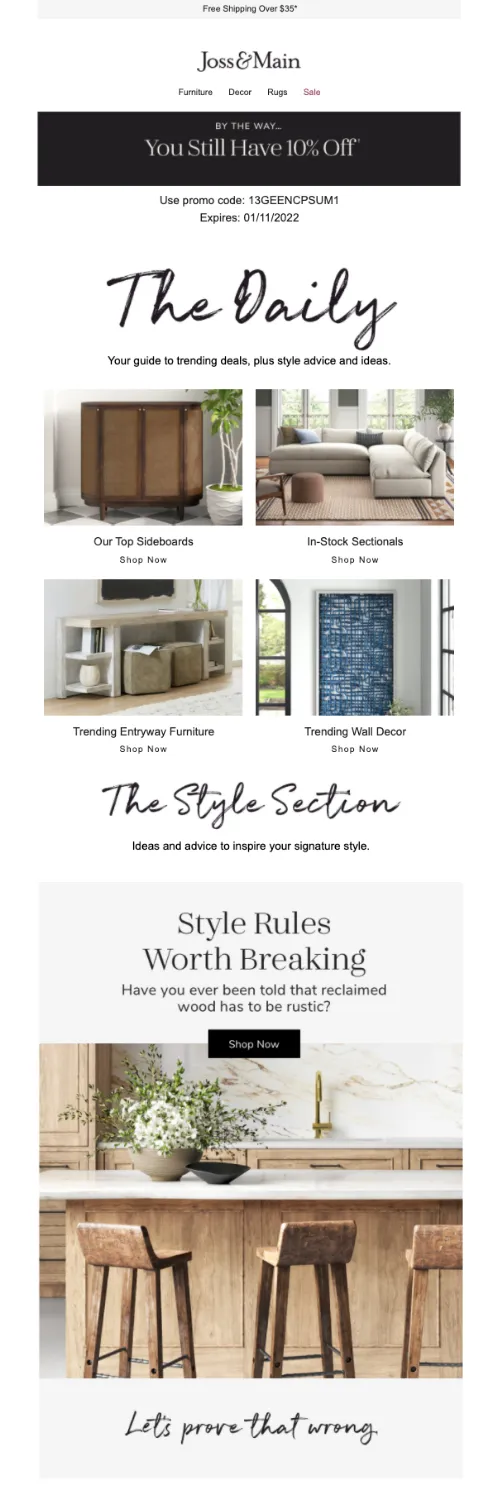
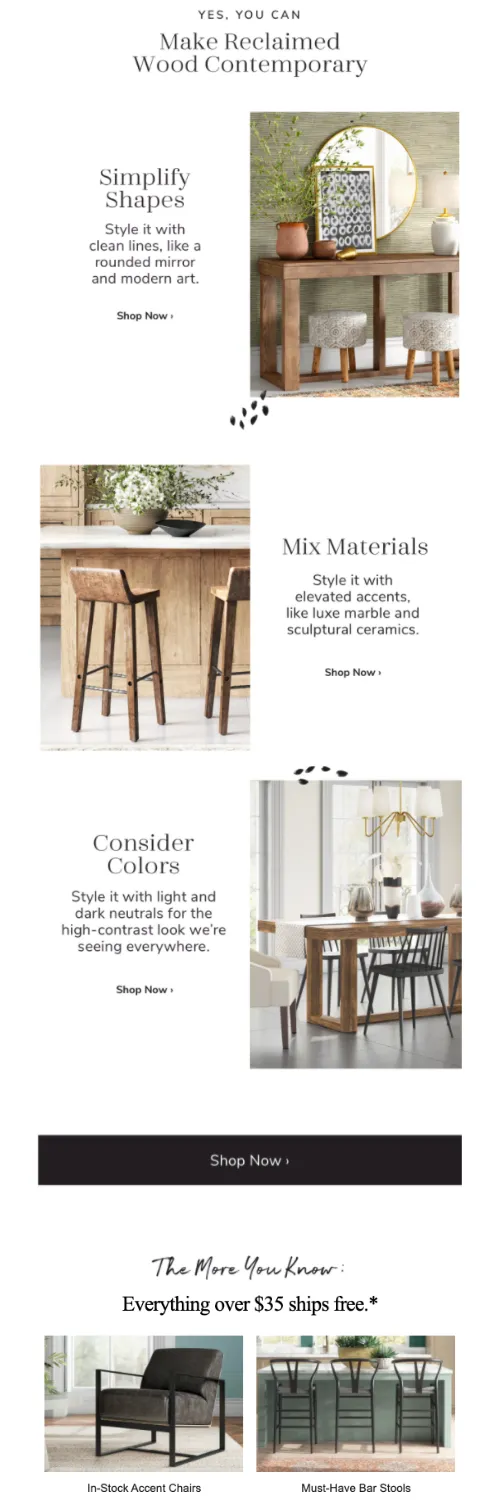
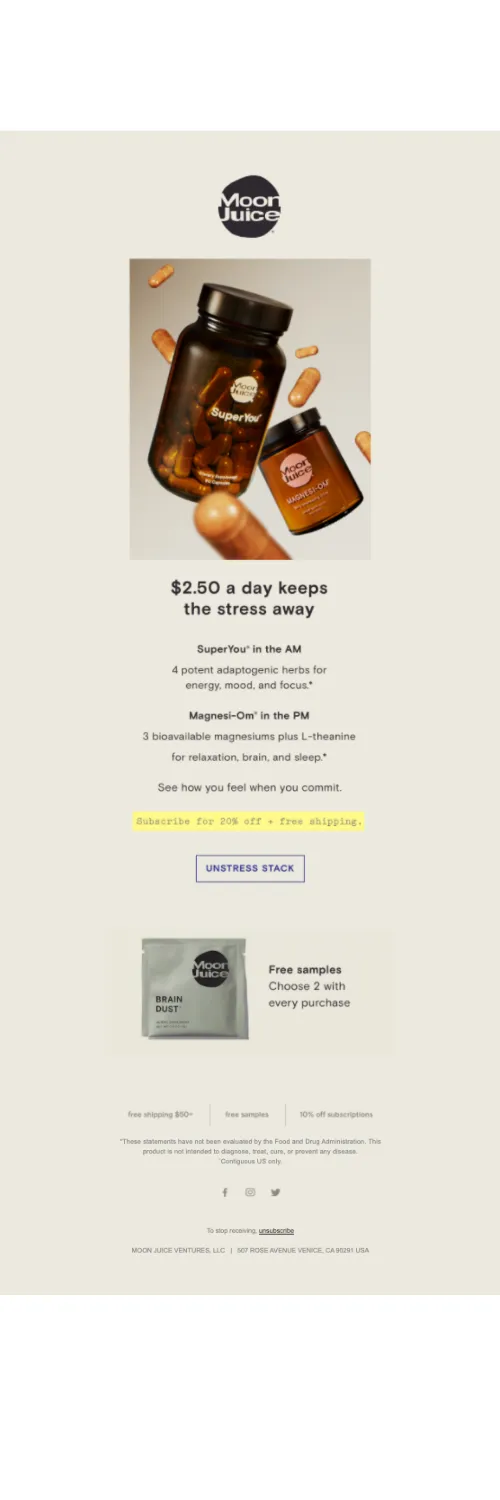
Curated content newsletters are useful in helping businesses to build thought leadership around their brands through sharing interesting findings and resources.
But they aren’t as commonly seen amongst ecommerce brands since they require quite a lot of effort to produce. And it’s not usually the first thing that comes to mind for many brands—cue paid ads, social media marketing, etc.
Curated content newsletters are a chance for ecommerce brands to offer something special and to differentiate themselves from the rest of their competition.
Will Watter, CEO of Western Rise shared with us that their curated content newsletter, The Diversion, is a 2-person effort and usually takes them 2-3 hours each week.
“We started it in March of 2020 because every email we were seeing from other brands was either delivering bad news about the pandemic or offering a sale. It just seemed like we should curate what we were already sharing in our company Slack anyways. The reactions we get from people about how much they love it have been great. It’s not a huge revenue driver, but it has been great for brand growth!”
Tips to make your curated content newsletter emails work:

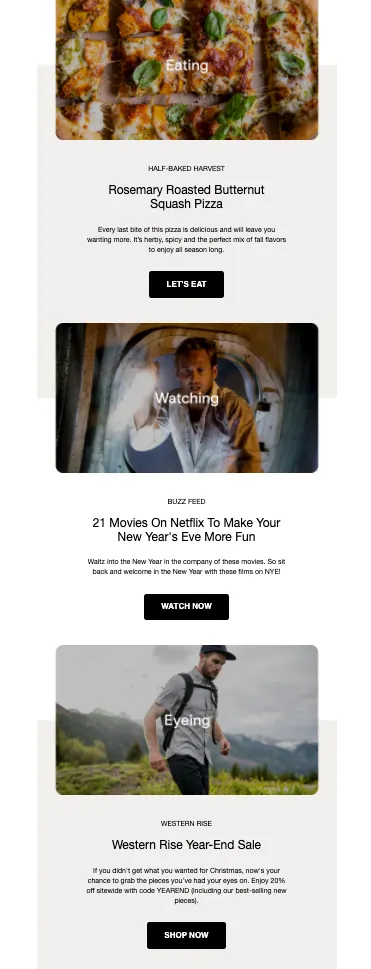
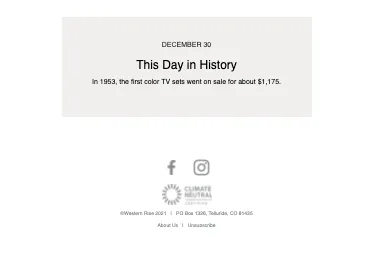
At the consideration stage, your potential customers are actively looking out for solutions to solve the specific problem they are facing. Some of their thought processes include evaluating the benefits of your product and also comparing your product or service with your competitors.
Bear in mind that these prospective customers already have some interest in your products or services. A little incentive or a little bit more information might suffice in tipping the scale in your favor.
Here are some emails to include in the consideration stage.
According to research, cart abandonment emails have the highest average conversion rate (2.63%) and click-to-conversion rate (21.78%) of any triggered ecommerce email.
The main goal of these emails is to reach out to customers who have abandoned their carts and to redirect them back to your ecommerce store to complete the purchase cycle. Since the act of adding items to the cart is a huge indicator of buying intent, there’s a high chance that a simple reminder will help you convert prospects to customers.
Needless to say, cart abandonment emails are a must-have for ecommerce email marketing.
Tips to make your cart abandonment emails work:

It’s in our nature to do a double-take when we see the price drop of a product we’re interested in. That’s why brick-and-mortar stores have huge sales banners hanging outside their storefronts. The same logic applies to price drop emails.
The price drop is a trigger for prospects that have seen the browse abandonment or cart abandonment emails. On top of reminding your prospects that they’re interested in the product, you’re giving them one more reason to buy it— the product is cheaper than before so why not?
Tips to make your price drop emails work:
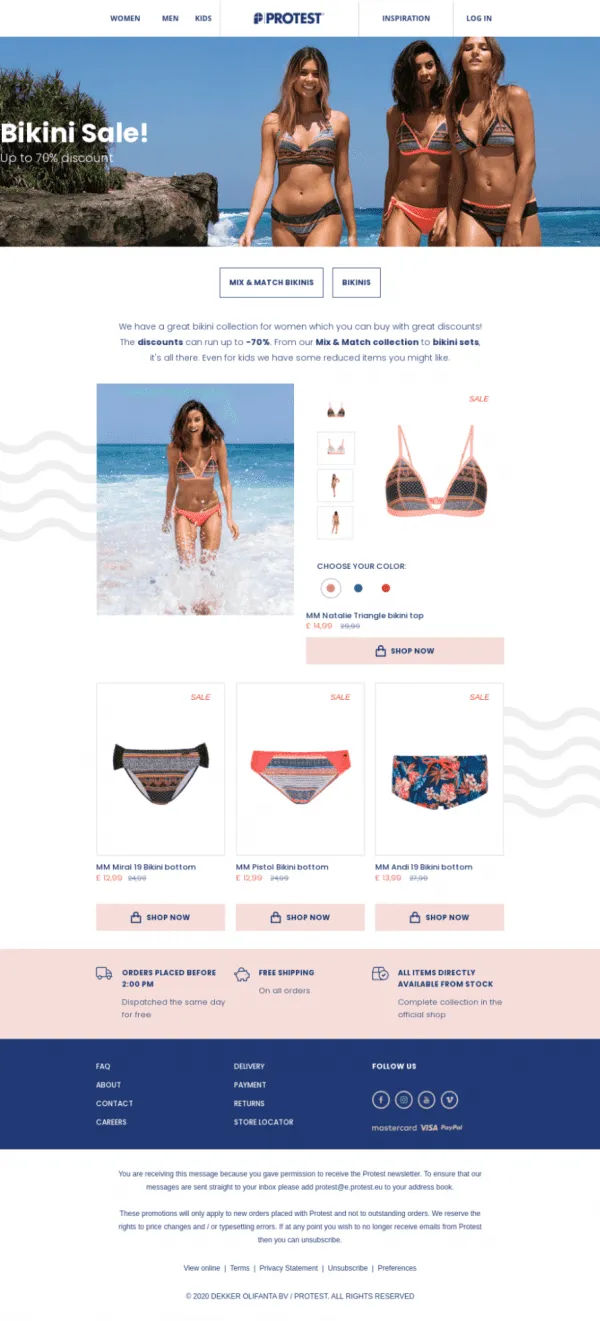
Supply chain issues are common in the ecommerce scene. And that means products going out of stock. In cases like these, frustrated prospective buyers can turn to a competitor to make a purchase instead. According to a report, retailers miss out on up to $1 trillion in sales because their products are out of stock.
That said, ecommerce brands need to trigger back-in-stock emails to help mitigate the unpleasant process experienced by prospects and also drive engagement to recover their revenue losses.
Tips to make your back-in-stock emails work:

This is the stage where your potential customers have already purchased a product from your store. It’s also a crucial step where ecommerce brands tend to forget or skip. After prospects have become your customers, it’s the best time for you to continue developing your relationship with them and maintain their interest in your products.
Tapping on the idea of inclusivity and community, it’s a way to nurture these new customers into purchasing a second and third time.
The first purchase welcome email is most of the time triggered after a customer checks out from your brand for the first time. Instead of only focusing on cross-selling or upselling, what you should do in this email is accentuate the community aspect to create a sense of belonging in these new customers.
Tips to make your first purchase welcome emails work:

Every ecommerce brand wants to collect invaluable feedback from its customers. High-quality customer feedback can boost your business in many ways: As social proof to establish the trustworthiness of your brand. As a way to strengthen relationships with your customers. Asking for their feedback using bulk email services, and actively using that feedback, is a great way to show your customers that their opinions and experiences are important to your brand.
Tips to make your feedback review request emails work:

If someone purchases one of your products, and you know they would get value from a related or complementary item, then it’s the perfect time to send a cross-sell email to that customer.
Even though cross-sell emails may have a small audience, they’re valuable because any conversion is a repeat purchase. Hence ROI from these emails can be very high, in terms of profit margin. Additionally, it generates awareness about many more products that your brand has.
Tips to make your cross-sell emails work:

Acquiring prospects is good, but retaining existing customers shouldn’t be compromised. The facts are such: The probability of selling to an existing customer is 60–70% while the probability of selling to a new prospect is 5-20%.
Retention is ultimately about increasing and maintaining engagement with your existing customers. Sure there’s some form of “selling” involved in these emails but it’s also more about being personal with your customers and getting them to be more “into” your brand and products.
After a customer has purchased a product, you’ll send an order confirmation email and that’s a given. Between the time of the purchase and when the customer actually receives the product, there’s some waiting involved. What better way to get your customers hooked onto your brand and other products in your collection than by storytelling?
There are plenty of ways to execute product education emails. It could be embedding it in a product launch, it could be sharing about a past collection, it could be promoting a brand mission or vision.
Tips to make your product education emails work:

At this stage of the customer lifecycle, your customers are happy customers. And happy customers have a higher tendency to share their positive experiences with other potential customers. So, turning your current customers into repeat customers and brand ambassadors should be your top priority.
If you haven’t already? It’s high time to build on that referral and loyalty program here.
These emails serve as one of the best ways to promote your referral program to your customers. Referral programs are win-win (maybe make that win-win-win) situations for both you and your customers and their friends. You get to spread the word about your brand and products, while your referrers are compensated for introducing a friend or family to your brand.
Tips to make your refer-a-friend emails work:
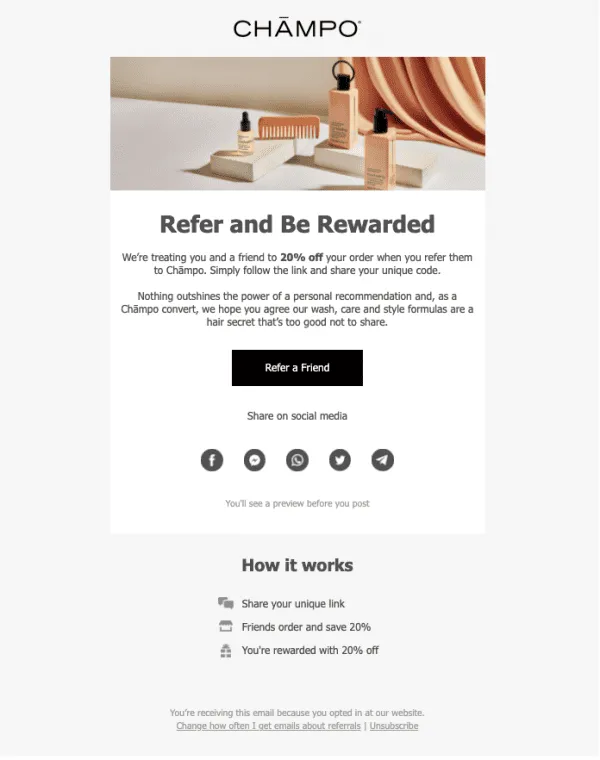
If you’re still sending the same emails to a new customer as you are to someone who has been a repeat customer, you might want to rethink that strategy. We’re pretty convinced that if you’re looking to increase the lifetime value of your loyal customers, putting a little more effort into this customer segmentation is the way to go.
With your VIP customers, you’re likely already aware of their favorite products, interests, and motivations based on collated customer data. This gives you ample opportunity to tailor your emails to them accordingly. Having this established relationship with your VIP customers also allows for room to expand on more creative designs and messaging.
Tips to make your VIP emails work:

It’s normal losing customers here and there. After all, it is part and parcel of running an online store. But given that it's common knowledge how valuable repeat customers are, if you’re not prepared with strategies to win back lapsed customers, you’re missing out on opportunities to eventually increase your revenue.
A win-back email can be used to re-engage inactive subscribers—someone who previously engaged with your brand but, they’ve stopped doing so for an abnormally long period of time.
Whatever the reason a subscriber turned inactive, a win-back email can help you speak directly to some of their concerns. These emails can also effectively convey messages to help convert these subscribers to repeat customers and increase customer lifetime value (LTV).
Tips to make your win-back emails work:
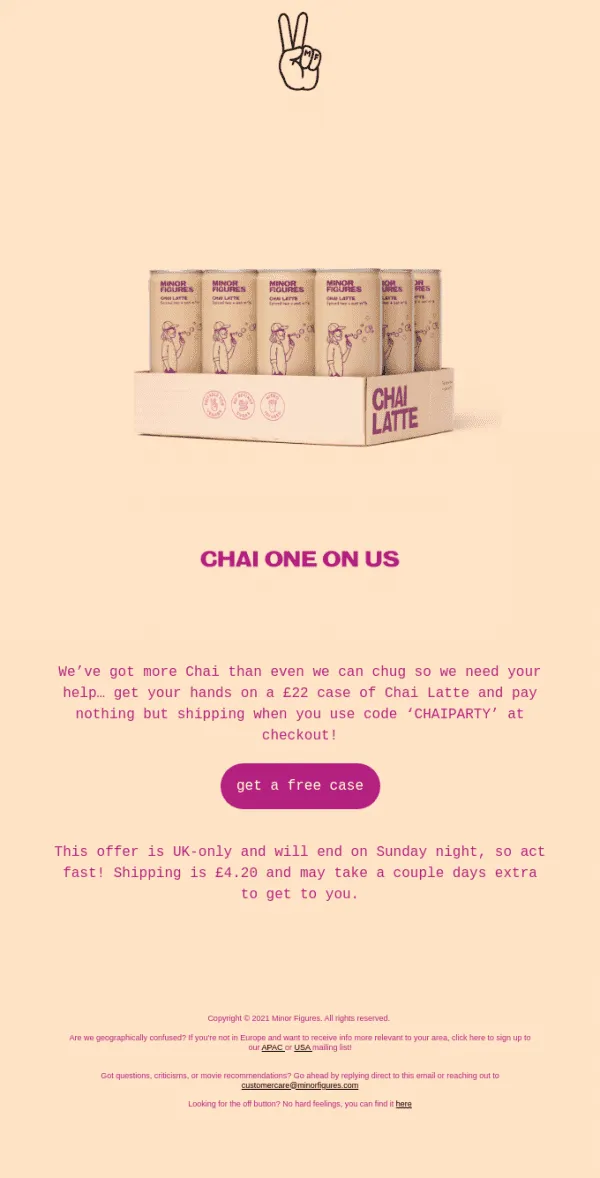
As self-explanatory as it is, a birthday email is triggered on the customer’s birthday. More often than not it includes a “birthday gift” as an appreciation for the customer.
Fun fact: Birthday emails actually get 481% higher transaction rates than other promotional emails.
It’s one of the emails that often gets overlooked but when done well, it serves to build great brand reputation and customer loyalty.
Tips to make your birthday emails work:

Holiday emails are another date-based email to leverage especially if your brand is pushing out seasonal products that tie in with the holiday. For example, fantasy books on witches and wizards during Halloween.
Holidays could also just be an excuse for you to pamper your customers with gifts or discount codes. Or if you have old stock in your inventory, this could be a great opportunity to make use of holidays and holiday emails.
Check out our Black Friday email marketing guide here!
Tips to make your holiday emails work:

A thank you message goes a long way. By showing gratitude to your customers, you’re letting them know that they’re being appreciated and at the same time strengthening the connection between them and your brand. It helps to establish the credibility of your brand and it’s also a perfect chance to invite customers to be a part of your social media community, referral programs, and even be an advocate.
Tips to make your thank you emails work:
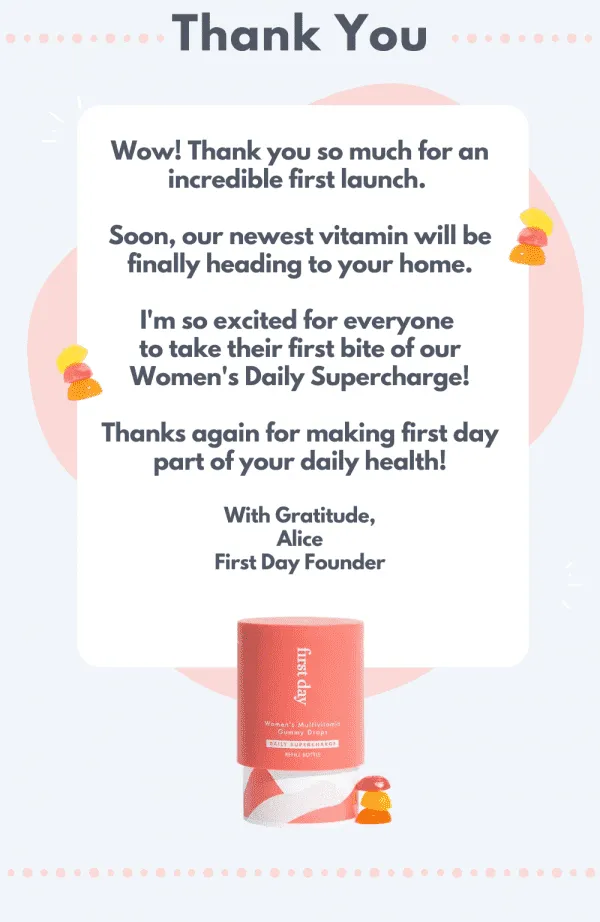
Yes, we know things would be a lot easier if they come in ready-made templates but unfortunately, they aren’t when it comes to lifecycle email marketing. What matters most is for your brand to identify when’s the best time to send the best message—based on your customer’s behavior and data.
And if you haven’t realized already, there are three big ideas that keep popping up throughout the article.
Perfect these concepts and you’ll see a difference in the way customers react to your email campaigns.
We’ll be coming up with more articles on email marketing so subscribe to our newsletter if you don’t want to miss out on the goodies!
Cheryl is a full-time Content Manager at ReferralCandy by day and a "Learnaholic" (aka always learning something new) by night. She loves learning new languages, storytelling, and creating experiences that are functional and visually compelling. She's also always lurking on Twitter so drop by and say hi!
Grow your sales at a ridiculously
lower CAC.